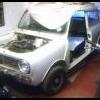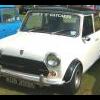
Carb Piston...
#1

Posted 11 November 2007 - 10:15 PM
I got twins on mine, and i had to service them as one was seized...
Ive fitted all the bits, cleaned everything up, and put them back on the car.
Filled them up with oil (3 in 1) and tried them to see how they felt when lifted...
One side is a fair bit stiffer than the other, and when released, one falls normally and the other much much quicker...
Should this be happening, and is this a problem? How do i got about rectifiying the situation???
Thanks
Add
#2

Posted 11 November 2007 - 10:25 PM
#3

Posted 11 November 2007 - 10:28 PM
I didnt occour to me that they could be different. They both seemed just as boingiy as each other. I would assume they are the same as i think the carbs came as a set together.
without sounding rude, i struggle to get it up one side, but the other is no problem...
I'll take a look to check oil is the same level, as i could have spilt some when fitting them.
Assuming its not the oil, what else could it be?
Thanks Bungle
Add
#4

Posted 11 November 2007 - 10:34 PM
It could be down to the needle and jet or the damper too.
#5

Posted 11 November 2007 - 11:17 PM
imo if there was marks on the piston then it woud stick rather than just be slower...
#6

Posted 11 November 2007 - 11:20 PM
Block the holes in the bottle of each piston (off the carb, holes on the bottom of the piston) then hold the dashpot so the piston falls out (dron't drop it) do this on each carb. If one is slower check for high spots and tweak then try again.
#7

Posted 11 November 2007 - 11:32 PM
If it's touching then you've got bigger problem and will be able to feel that just by moving them as you are...do they both drop freely?
As I understand it, they are damped on the way up, but not on the way down. I'm not sure how critical the drop speeds are, but them being different should only change the mixture when you snap the throttle shut. There being different daping rates on the way up will pose more problems I'd have thought (response). Do both the damper pistons seem complete and the same?
#8

Posted 12 November 2007 - 12:04 AM
#9

Posted 12 November 2007 - 12:15 AM
I don't reckon a drop test will tell you much, as it is testing the fit tolerance of the piston inside the dashpot bore. Without the engine running, this bore isn't really doing anything, that's why you need to plug the holes for the test.
..but the vizard book told me it....it's law!
#10

Posted 12 November 2007 - 12:56 PM
The springs are a possibility. They could be different, they could have been modified by a previous owner, one could be broken.
The fit of the piston in the vacuum chamber could be wrong. They're really matched sets and a previous owner could have mixed the front/rear carb parts.
The dashpot pistons are also matched to their pistons, they could be mixed.
Lastly, a lot of you guys are used to the spring biased carb needles. I believe you'll find that even these benefit from jet tube centering as was required on the early cars with fixed needles. If the needle is scrubbing the walls of the jet tube or there is too much side pressure on a spring biased needle the piston will have more drag on it.
You're going to need to tear the carbs down one part at a time to determine which part (or parts) are causing the problem.
#11

Posted 12 November 2007 - 01:08 PM
The damper has a pretty much equal effect in both directions by the way.
#12

Posted 12 November 2007 - 02:47 PM
How or what controlls the speed at which the needle piston falls in a HS4 Carb???
I got twins on mine, and i had to service them as one was seized...
Ive fitted all the bits, cleaned everything up, and put them back on the car.
Filled them up with oil (3 in 1) and tried them to see how they felt when lifted...
One side is a fair bit stiffer than the other, and when released, one falls normally and the other much much quicker...
Should this be happening, and is this a problem? How do i got about rectifiying the situation???
Thanks
Add
some previous experiences with various sets iv'e owned: -
How did you unseize the carb? Was it corrosion or just plain old gum/dirt?
Was the seized carb the one which is now stiff or the one which is now loose? The Piston/Chamber is a matched pair. If the inner surface of the Chamber is over size or damaged due to the cleaning operation then it may fall very quickly indeed due to there being insufficient vacuum in the Chamber above the Piston, this would also prevent it opening at same rate or amount as the other carb as it requires manifold vacuum to lift the piston and large gaps between the piston and the Chamber would create vacuum leaks.
Only carburrettor cleaner should be used to clean. In the event of high spots metal polish can be used but very sparingly.
Without a spring, no damper oil and the vacuun ports in the base of the piston sealed, each piston should take a couple of seconds to fall and both should be pretty much equal, they should not just immediately drop out of the Chamber.
The idea of the spring and oil is to give a damping or transition effect between small and large throttle openings otherwise the mixture would suddenly go lean when you floor the pedal and the engine would try to die. It does the same as the accelerator pump jet on a fixed jet carb.
Edited by littlejem59, 12 November 2007 - 03:44 PM.
1 user(s) are reading this topic
0 members, 1 guests, 0 anonymous users




















